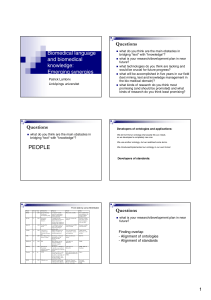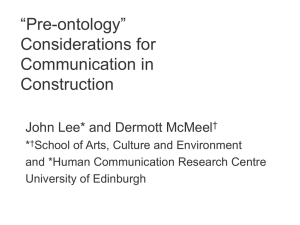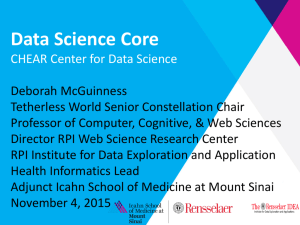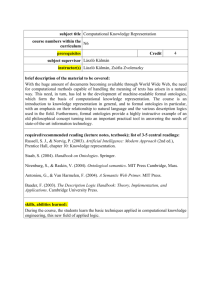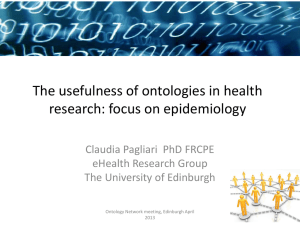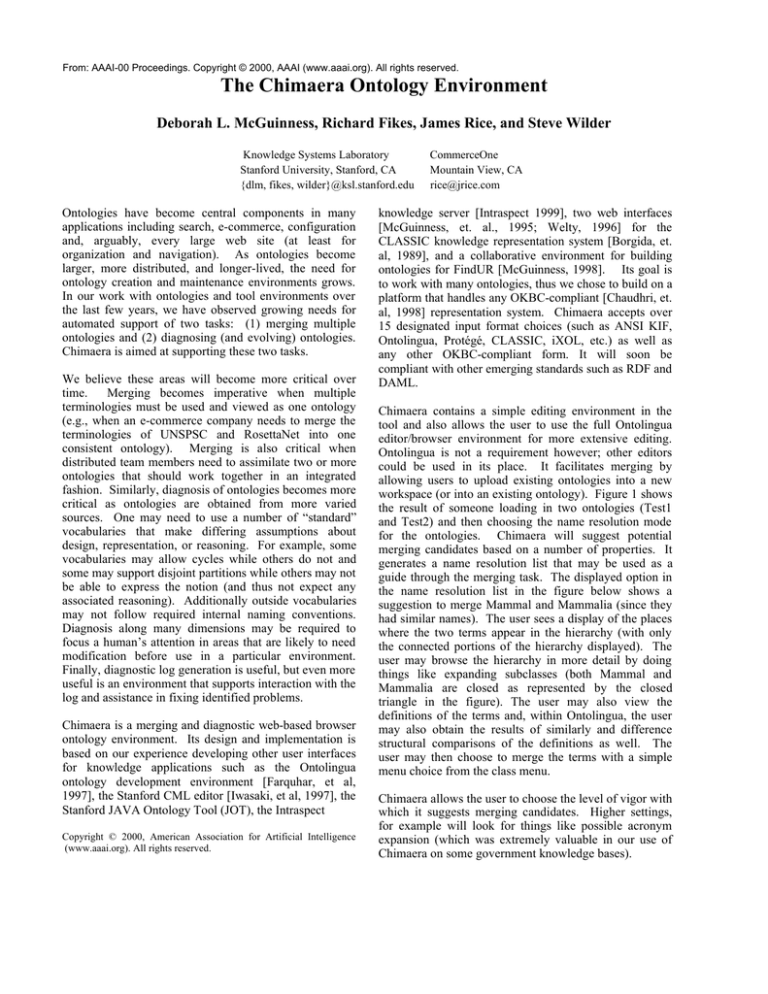
From: AAAI-00 Proceedings. Copyright © 2000, AAAI (www.aaai.org). All rights reserved.
The Chimaera Ontology Environment
Deborah L. McGuinness, Richard Fikes, James Rice, and Steve Wilder
Knowledge Systems Laboratory
Stanford University, Stanford, CA
{dlm, fikes, wilder}@ksl.stanford.edu
Ontologies have become central components in many
applications including search, e-commerce, configuration
and, arguably, every large web site (at least for
organization and navigation). As ontologies become
larger, more distributed, and longer-lived, the need for
ontology creation and maintenance environments grows.
In our work with ontologies and tool environments over
the last few years, we have observed growing needs for
automated support of two tasks: (1) merging multiple
ontologies and (2) diagnosing (and evolving) ontologies.
Chimaera is aimed at supporting these two tasks.
We believe these areas will become more critical over
time.
Merging becomes imperative when multiple
terminologies must be used and viewed as one ontology
(e.g., when an e-commerce company needs to merge the
terminologies of UNSPSC and RosettaNet into one
consistent ontology). Merging is also critical when
distributed team members need to assimilate two or more
ontologies that should work together in an integrated
fashion. Similarly, diagnosis of ontologies becomes more
critical as ontologies are obtained from more varied
sources. One may need to use a number of “standard”
vocabularies that make differing assumptions about
design, representation, or reasoning. For example, some
vocabularies may allow cycles while others do not and
some may support disjoint partitions while others may not
be able to express the notion (and thus not expect any
associated reasoning). Additionally outside vocabularies
may not follow required internal naming conventions.
Diagnosis along many dimensions may be required to
focus a human’s attention in areas that are likely to need
modification before use in a particular environment.
Finally, diagnostic log generation is useful, but even more
useful is an environment that supports interaction with the
log and assistance in fixing identified problems.
Chimaera is a merging and diagnostic web-based browser
ontology environment. Its design and implementation is
based on our experience developing other user interfaces
for knowledge applications such as the Ontolingua
ontology development environment [Farquhar, et al,
1997], the Stanford CML editor [Iwasaki, et al, 1997], the
Stanford JAVA Ontology Tool (JOT), the Intraspect
Copyright © 2000, American Association for Artificial Intelligence
(www.aaai.org). All rights reserved.
CommerceOne
Mountain View, CA
rice@jrice.com
knowledge server [Intraspect 1999], two web interfaces
[McGuinness, et. al., 1995; Welty, 1996] for the
CLASSIC knowledge representation system [Borgida, et.
al, 1989], and a collaborative environment for building
ontologies for FindUR [McGuinness, 1998]. Its goal is
to work with many ontologies, thus we chose to build on a
platform that handles any OKBC-compliant [Chaudhri, et.
al, 1998] representation system. Chimaera accepts over
15 designated input format choices (such as ANSI KIF,
Ontolingua, Protégé, CLASSIC, iXOL, etc.) as well as
any other OKBC-compliant form. It will soon be
compliant with other emerging standards such as RDF and
DAML.
Chimaera contains a simple editing environment in the
tool and also allows the user to use the full Ontolingua
editor/browser environment for more extensive editing.
Ontolingua is not a requirement however; other editors
could be used in its place. It facilitates merging by
allowing users to upload existing ontologies into a new
workspace (or into an existing ontology). Figure 1 shows
the result of someone loading in two ontologies (Test1
and Test2) and then choosing the name resolution mode
for the ontologies. Chimaera will suggest potential
merging candidates based on a number of properties. It
generates a name resolution list that may be used as a
guide through the merging task. The displayed option in
the name resolution list in the figure below shows a
suggestion to merge Mammal and Mammalia (since they
had similar names). The user sees a display of the places
where the two terms appear in the hierarchy (with only
the connected portions of the hierarchy displayed). The
user may browse the hierarchy in more detail by doing
things like expanding subclasses (both Mammal and
Mammalia are closed as represented by the closed
triangle in the figure). The user may also view the
definitions of the terms and, within Ontolingua, the user
may also obtain the results of similarly and difference
structural comparisons of the definitions as well. The
user may then choose to merge the terms with a simple
menu choice from the class menu.
Chimaera allows the user to choose the level of vigor with
which it suggests merging candidates. Higher settings,
for example will look for things like possible acronym
expansion (which was extremely valuable in our use of
Chimaera on some government knowledge bases).
Figure 1: Chimæra in name resolution mode suggesting a merge of Mammal and Mammalia
Chimaera also supports a taxonomy resolution mode. It
looks for a number of syntactic term relationships (such as
<X-Y> and <Y> since the two are usually subclass
related). When attached to a classifier, it can look for
semantic subsumption relationships as well
Chimaera includes an analysis capability that allows users
to run a diagnostic suite of tests selectively or in their
entirety. The output is displayed as an interactive log that
allows users to see the results of the tests and also to
explore the results. The tests include incompleteness tests,
syntactic checks, taxonomic analysis, and semantic checks.
We built this system to provide collaborators with varying
training essentially a “todo” list containing updates that
would likely need to be done before the ontologies would
be of the most use to us. The list contains things such as
terms that are used but that are not defined, to terms that
have contradictory ranges, to cycles detected in the
ontology definitions. We are extending the system to
include a rule language that allows users to specify
additional tests that our environment should include in its
diagnostic tool suite so that users may customize the
diagnostics to their particular environment.
Chimaera was used in the High Performance Knowledge
Base project to analyze incoming ontologies. It is also
being used and/or evaluated by companies including
VerticalNet and Cisco. More information is available from
[McGuinness, et. al, 2000], or from the web site
http://www.ksl.Stanford.EDU/software/chimaera/ which
also includes links to a tutorial and a movie demonstration.
It is licensable for use.
Acknowledgments. The authors wish to thank DARPA for
its support of this work under contract N66001-97-C-8554,
Large-Scale Repositories of Highly Expressive Knowledge.
References.
A. Borgida, R.J. Brachman, D.L. McGuinness, and L.A.
Resnick; CLASSIC: A Structural Data Model for Objects,
SIGMOD, Oregon, 1989
V. Chaudhri, A. Farquhar, R. Fikes, P. Karp, and J. Rice;
OKBC: A Programmatic Foundation for Knowledge Base
Interoperability; AAAI-98.
A. Farquhar, R. Fikes, and J. Rice; The Ontolingua Server:
a Tool for Collaborative Ontology Construction; Intl.
Journal of Human-Computer Studies 46, 1997.
Intraspect Knowledge Server, Intraspect Corp., 1999.
(http://www.intraspect.com/product_info_solution.htm)
Y. Iwasaki, A. Farquhar, R. Fikes, & J. Rice; A Web-based
Compositional Modeling System for Sharing of Physical
Knowledge. Morgan Kaufmann, Nagoya, Japan, 1997.
D.L. McGuinness; Ontological Issues for KnowledgeEnhanced Search; Proceedings of Formal Ontology in
Information Systems, June 1998. Also in Frontiers in
Artificial Intelligence and Applications, IOS-Press,
Washington, DC, 1998.
D.L. McGuinness, R. Fikes, J. Rice, and S. Wilder. An
Environment for Merging and Testing Large Ontologies.
Proceedings of Knowledge Representation 2000.
D.L. McGuinness, L.A. Resnick, and C. Isbell; Description
Logic in Practice: A CLASSIC: Application; IJCAI, 1995.
United Nations Standard Product and Services
Classification
(UNSPSC)
Code
organization.
http://www.unspsc.org/home.htm
C. Welty; An HTML Interface for CLASSIC; Proceedings
of the 1996 International Workshop on Description Logics;
AAAI Press; November, 1996.



